Wildfires Risk Assessment Using Hotspot Analysis and Results Application to Wildfires Strategic Response in the Region of Tangier-Tetouan-Al Hoceima, Morocco
Abstract
1. Introduction
2. Materials and Methods
2.1. Study Area
2.2. Data Sets
2.2.1. Fire_CCI51 Burned Area Products
2.2.2. Fire Information for Resource Management System (FIRMS) Data
2.3. Spatial Autocorrelation Analysis
2.4. Hotspot Mapping
2.5. Wildfire Strategic Responses
2.5.1. Wildfire Risk Assessment
2.5.2. Current Conditions
- Wildfire management
- Land use and forest connectivity
2.5.3. Identifying Wildfire Strategic Responses
- Mapping wildfire homogeneous zones
- Defining response categories
- a-.
- Maintain: Includes areas protected from fire; measures adopted so far must be maintained;
- b-.
- Reinforce: Includes areas not fully protected against fire; measures adopted so far must be reinforced;
- c-.
- Monitor and raise awareness: Includes areas not fully protected with a high risk of fire outbreaks where priority must be given to monitoring and public awareness actions.
3. Results
3.1. Wildfire Statistics
3.2. Forest Fires Statistics
3.3. Spatial Autocorrelation Analysis
3.4. Hotspot Mapping
3.5. Wildfire Strategic Responses
3.5.1. Mapping Wildfire Homogeneous Zones
- Zone 1:
- Zone 2:
- Zone 3:
- Zone 4:
- Zone 5:
- Zone 6:
3.5.2. Strategic Response Categories
4. Discussions
4.1. Wildfires Statistics
4.2. Spatial Autocorrelation Analysis
4.3. Hotspot Mapping
4.4. Wildfire Strategic Responses
4.5. Limitations
5. Conclusions
Author Contributions
Funding
Institutional Review Board Statement
Informed Consent Statement
Data Availability Statement
Acknowledgments
Conflicts of Interest
References
- Tyukavina, A.; Potapov, P.; Hansen, M.C.; Pickens, A.H.; Stehman, S.V.; Turubanova, S.; Parker, D.; Zalles, V.; Lima, A.; Kommareddy, I.; et al. Global Trends of Forest Loss Due to Fire From 2001 to 2019. Front. Remote Sens. 2022, 3, 825190. [Google Scholar] [CrossRef]
- WWF. Fires, Forests and the Future: A Crisis Raging out of Control? 2020. Available online: https://www.readkong.com/page/fires-forests-and-the-future-a-crisis-raging-out-of-6354457 (accessed on 6 January 2023).
- Joint Research Centre (European Commission); Schulte, E.; Maianti, P.; Boca, R.; De Rigo, D.; Ferrari, D.; Durrant, T.; Loffler, P.; San-Miguel-Ayanz, J.; Branco, A.; et al. Forest Fires in Europe, Middle East and North Africa 2016; Publications Office of the European Union: Luxembourg, Germany, 2017; Available online: https://data.europa.eu/doi/10.2760/17690 (accessed on 6 January 2023).
- Assali, F.; Mharzi Alaoui, H.; Rouchdi, M.; et Badraoui, M. Modelling and mapping forest fire ignition risk in North-West Morocco (Chefchaouen-Ouazzane Region). Rev. Ecol. Terre Vie 2016, 71, 111–128. [Google Scholar]
- Boubekraoui, H.; Maouni, Y.; Ghallab, A.; Draoui, M.; Maouni, A. Spatio-Temporal Analysis and Identification of Deforestation Hotspots in the Moroccan Western Rif. Trees For. People 2023, 12, 100388. [Google Scholar] [CrossRef]
- Zidane, I.E.; Lhissou, R.; Ismaili, M.; Manyari, Y.; Bouli, A.; Mabrouki, M. Characterization of Fire Severity in the Moroccan Rif Using Landsat-8 and Sentinel-2 Satellite Images. Int. J. Adv. Sci. Eng. Inf. Technol. 2021, 11, 72–83. Available online: http://ijaseit.insightsociety.org/index.php?option=com_content&view=article&id=9&Itemid=1&article_id=10342 (accessed on 8 January 2023). [CrossRef]
- Alaoui, H.M.; Assali, F.; Rouchdi, M.; Tahiri, D.; Lahssini, S.; Aafi, A.; Moukrim, S. Mapping of fire intensity and of sensibility to crown fires in Mediterranean forests. Case of the province of Chefchaouen in northern Morocco. Rev. Ecol. 2017, 42, 387–409. [Google Scholar]
- Mohajane, M.; Costache, R.; Karimi, F.; Pham, Q.B.; Essahlaoui, A.; Nguyen, H.; Laneve, G.; Oudija, F. Application of remote sensing and machine learning algorithms for forest fire mapping in a Mediterranean area. Ecol. Indic. 2021, 129, 107869. [Google Scholar] [CrossRef]
- Champin, L.; Taïbi, A.N.; Ballouche, A. Spatial Analysis of the Occurrence and Spread of Wildfires in Southwest Madagascar. Fire 2022, 5, 98. [Google Scholar] [CrossRef]
- Roy, D.P.; Landmann, T. Characterizing the surface heterogeneity of fire effects using multi-temporal reflective wavelength data. Int. J. Remote Sens. 2005, 26, 4197–4218. [Google Scholar] [CrossRef]
- Haut-Commissariat au Plan (HCP). Monographie Régionale de Tanger-Tétouan-Al Hoceima. 2020. Available online: https://www.hcp.ma/region-tanger/attachment/2141567/ (accessed on 12 June 2022).
- Ministère de l’Energie, des Mines et de l’Environnement-Département de l’environnement (MEME). Elaboration D’un Plan Climat Territorial Pour la Région de Tanger-Tétouan-Al Hoceima; RAPPORT DE LA MISSION 3: Conception et élaboration d’un Plan D’adaptation Prioritaire; MEME: Rabat, Morocco, 2021; 154p. [Google Scholar]
- HCEFLCD. Haut-Commissariat aux Eaux et Forêts et à la Lutte Contre la Désertification. In Base de Données Cartographiques de L’inventaire Forestier National, Rapport Interne; Haut-Commissariat Aux Eaux et Forêts et à la Lutte Contre la Désertification: Rabat, Chellah, Quartier Administratif, Morocco, 2004. [Google Scholar]
- ANEF. Agence Nationale des Eaux et Forêts. In Incendies des Forêts—Chiffres Clés; Agence Nationale des Eaux et Forêts: Rabat, Chellah, Quartier Administratif, Morocco, 2023. Available online: http://www.eauxetforets.gov.ma/Pages/Incendies-Chiffres-cles.aspx (accessed on 31 January 2023).
- Chuvieco, E.; Pettinari, M.L.; Lizundia-Loiola, J.; Storm, T.; Padilla Parellada, M. ESA Fire Climate Change Initiative (Fire_cci): MODIS Fire_cci Burned Area Pixel Product, Version 5.1; Centre for Environmental Data Analysis (CEDA): Chilton, UK, 2018. [Google Scholar] [CrossRef]
- ESA. European Space Agency (ESA) Climate Change Initiative (CCI) Programme, Fire ECV FireCCI51: MODIS Fire_cci Burned Area Pixel Product, Version 5.1|Earth Engine Data Catalog. Google Developers. 2018. Available online: https://developers.google.com/earth-engine/datasets/catalog/ESA_CCI_FireCCI_5_1 (accessed on 12 January 2023).
- Anselin, L.; Getis, A. Spatial statistical analysis and geographic information systems. Ann. Reg. Sci. 1992, 26, 19–33. [Google Scholar] [CrossRef]
- Anselin, L. The Local Indicators of Spatial Association—LISA. Geogr. Anal. 1995, 27, 93–115. [Google Scholar] [CrossRef]
- Oliveau, S. Autocorrélation spatiale: Leçons du changement d’échelle. L’Espace Géograph. 2010, 39, 51–64. [Google Scholar] [CrossRef]
- Araza, A.B.; Castillo, G.B.; Buduan, E.D.; Hein, L.; Herold, M.; Reiche, J.; Gou, Y.; Villaluz, M.G.Q.; Razal, R.A. Intra-Annual Identification of Local Deforestation Hotspots in the Philippines Using Earth Observation Products. Forests 2021, 12, 1008. [Google Scholar] [CrossRef]
- Khan, S.D.; Gadea, O.C.A.; Alvarado, A.T.; Tirmizi, O.A. Surface Deformation Analysis of the Houston Area Using Time Series Interferometry and Emerging Hot Spot Analysis. Remote Sens. 2022, 14, 3831. [Google Scholar] [CrossRef]
- Getis, A.; Ord, J.K. The Analysis of Spatial Association by Use of Distance Statistics. Geogr. Anal. 2010, 24, 189–206. [Google Scholar] [CrossRef]
- ESRI. Optimized Hot Spot Analysis (Spatial Statistics)—ArcMap|Documentation. 2023. Available online: https://desktop.arcgis.com/fr/arcmap/latest/tools/spatial-statistics-toolbox/optimized-hot-spot-analysis.htm (accessed on 2 February 2023).
- Anselin, L.; Rey, S.J. (Eds.) Perspectives on Spatial Data Analysis; Advances in Spatial Science; Springer: Berlin/Heidelberg, Germany; New York, NY, USA, 2010. [Google Scholar] [CrossRef]
- Ord, J.K.; Getis, A. Local Spatial Autocorrelation Statistics: Distributional Issues and an Application. Geogr. Anal. 1995, 27, 286–306. [Google Scholar] [CrossRef]
- Harris, N.L.; Goldman, E.; Gabris, C.; Nordling, J.; Minnemeyer, S.; Ansari, S.; Lippmann, M.; Bennett, L.; Raad, M.; Hansen, M.; et al. Using spatial statistics to identify emerging hot spots of forest loss. Environ. Res. Lett. 2017, 12, 024012. [Google Scholar] [CrossRef]
- Thompson, M.P.; Bowden, P.; Brough, A.; Scott, J.H.; Gilbertson-Day, J.; Taylor, A.; Anderson, J.; Haas, J.R. Application of Wildfire Risk Assessment Results to Wildfire Response Planning in the Southern Sierra Nevada, California, USA. Forests 2016, 7, 64. [Google Scholar] [CrossRef]
- Thompson, M.P.; MacGregor, D.G.; Calkin, D. Risk Management: Core Principles and Practices, and Their Relevance to Wildland Fire; RMRS-GTR-350; U.S. Department of Agriculture, Forest Service, Rocky Mountain Research Station: Ft. Collins, CO, USA, 2016. [CrossRef]
- Oliveira, S.; Rocha, J.; Sá, A. Wildfire risk modeling. Curr. Opin. Environ. Sci. Health 2021, 23, 100274. [Google Scholar] [CrossRef]
- Nur, A.S.; Kim, Y.J.; Lee, J.H.; Lee, C.-W. Spatial Prediction of Wildfire Susceptibility Using Hybrid Machine Learning Models Based on Support Vector Regression in Sydney, Australia. Remote Sens. 2023, 15, 760. [Google Scholar] [CrossRef]
- Cao, Y.; Wang, M.; Liu, K. Wildfire Susceptibility Assessment in Southern China: A Comparison of Multiple Methods. Int. J. Disaster Risk Sci. 2017, 8, 164–181. [Google Scholar] [CrossRef]
- Ager, A.A.; Palaiologou, P.; Evers, C.R.; Day, M.A.; Ringo, C.; Short, K. Wildfire exposure to the wildland urban interface in the western US. Appl. Geogr. 2019, 111, 102059. [Google Scholar] [CrossRef]
- Cáceres, C.F. Using GIS in Hotspots Analysis and for Forest Fire Risk Zones Mapping in the Yeguare Region, Southeastern Honduras. Pap. Resour. Anal. 2011, 13, 1–14. [Google Scholar] [CrossRef]
- Dhar, T.; Bhatta, B.; Aravindan, S. Forest fire occurrence, distribution and risk mapping using geoinformation technology: A case study in the sub-tropical forest of the Meghalaya, India. Remote. Sens. Appl. Soc. Environ. 2023, 29, 100883. [Google Scholar] [CrossRef]
- ANEF. Agence Nationale des Eaux et Forêts. In Incendies des Forêts—Stratégie de Gestion; Agence Nationale des Eaux et Forêts: Rabat, Chellah, Quartier Administratif, Morocco, 2023. Available online: http://www.eauxetforets.gov.ma/Pages/Incendies-strategie-de-gestion.aspx (accessed on 7 February 2023).
- Chebli, Y.; Chentouf, M.; Ozer, P.; Hornick, J.-L.; Cabaraux, J.-F. Forest and silvopastoral cover changes and its drivers in northern Morocco. Appl. Geogr. 2018, 101, 23–35. [Google Scholar] [CrossRef]
- Benbrahim, K.F.; Ismaili, M.; Benbrahim, S.; Tribak, A. Problems of Environmental Degradation by Desertification and Deforestation: The Impact of the Phenomenon in Morocco. Sécheresse 2004, 15, 307–320. [Google Scholar]
- Taïqui, L. La dégradation écologique au Rif marocain: Nécessités d’une nouvelle approche. MDTRRA 1997, 16, 5–17. [Google Scholar] [CrossRef]
- Brown, C.F.; Brumby, S.P.; Guzder-Williams, B.; Birch, T.; Hyde, S.B.; Mazzariello, J.; Czerwinski, W.; Pasquarella, V.J.; Haertel, R.; Ilyushchenko, S.; et al. Dynamic World, Near real-time global 10 m land use land cover mapping. Sci. Data 2022, 9, 251. [Google Scholar] [CrossRef]
- Dong, J.; Xiao, X.; Sheldon, S.; Biradar, C.; Zhang, G.; Duong, N.D.; Hazarika, M.; Wikantika, K.; Takeuhci, W.; Moore, B. A 50-m Forest Cover Map in Southeast Asia from ALOS/PALSAR and Its Application on Forest Fragmentation Assessment. PLoS ONE 2014, 9, e85801. [Google Scholar] [CrossRef]
- Grovel, R. La préservation des forêts du Rif centro-occidental: Un enjeu de développement de la montagne rifaine/Preservation of forests in the central western Rif massif: A key element in the development of the Rif Mountains. RGA 1996, 84, 75–94. [Google Scholar] [CrossRef]
- Al Karkouri, J. Les milieux montagneux marocains à l’épreuve du changement climatique (cas de la montagne rifaine). Hespéris-Tamuda 2017, LII, 237–267. [Google Scholar]
- Castro, I.; Stan, A.B.; Taiqui, L.; Schiefer, E.; Ghallab, A.; Derak, M.; Fulé, P.Z. Detecting Fire-Caused Forest Loss in a Moroccan Protected Area. Fire 2022, 5, 51. [Google Scholar] [CrossRef]
- Dunn, C.J.; O’connor, C.D.; Abrams, J.; Thompson, M.P.; Calkin, D.E.; Johnston, J.D.; Stratton, R.; Gilbertson-Day, J. Wildfire risk science facilitates adaptation of fire-prone social-ecological systems to the new fire reality. Environ. Res. Lett. 2020, 15, 025001. [Google Scholar] [CrossRef]
- Yan, X.; Ohara, T.; Akimoto, H. Bottom-up estimate of biomass burning in mainland China. Atmos. Environ. 2006, 40, 5262–5273. [Google Scholar] [CrossRef]
- Chen, D.; Pereira, J.M.; Masiero, A.; Pirotti, F. Mapping fire regimes in China using MODIS active fire and burned area data. Appl. Geogr. 2017, 85, 14–26. [Google Scholar] [CrossRef]
- Smith, H.; de Beurs, K.; Neeson, T. Evaluation of low-resolution remotely sensed datasets for burned area assessment within the wildland-urban interface. Remote Sens. Appl. Soc. Environ. 2022, 26, 100752. [Google Scholar] [CrossRef]
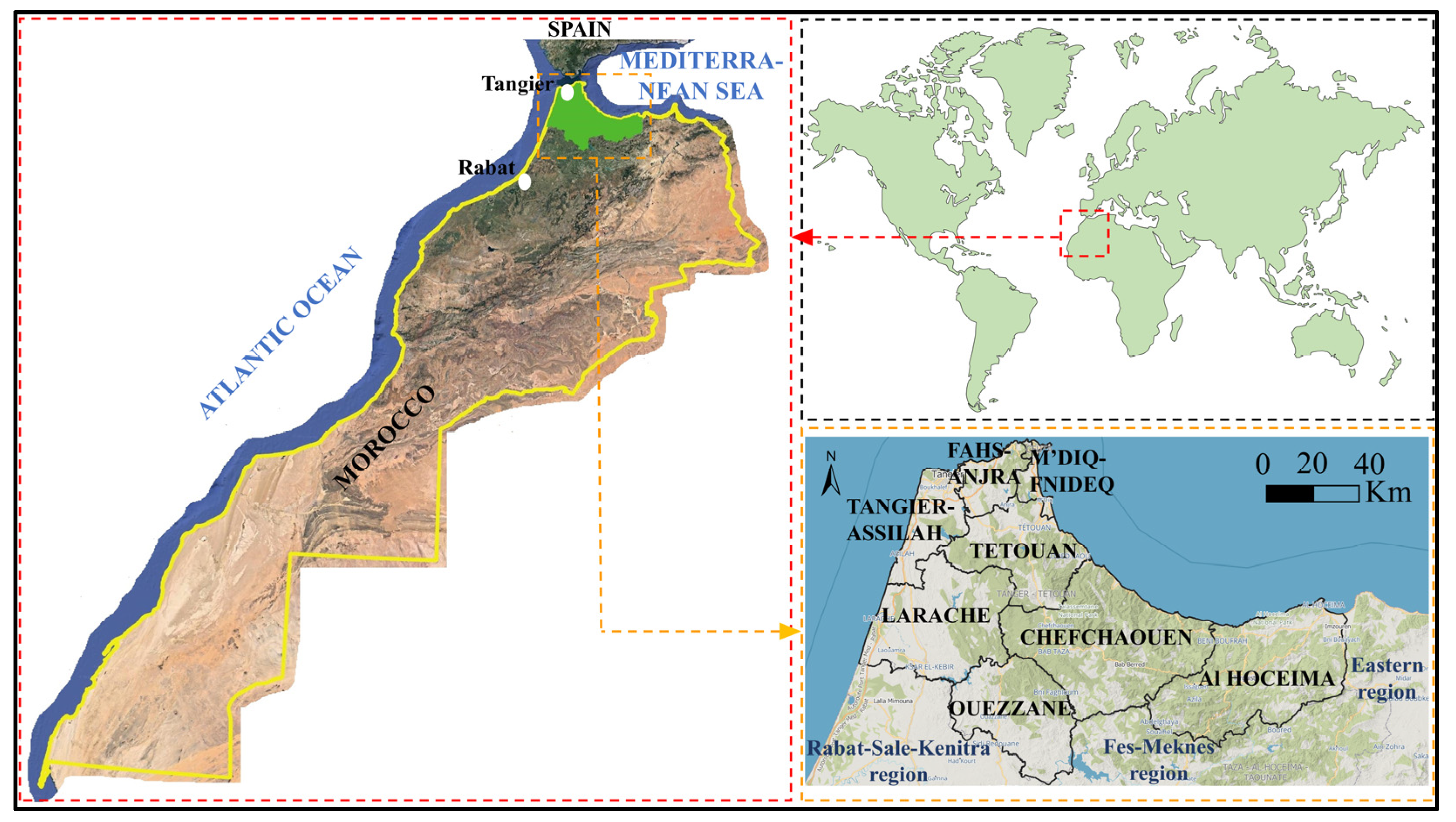
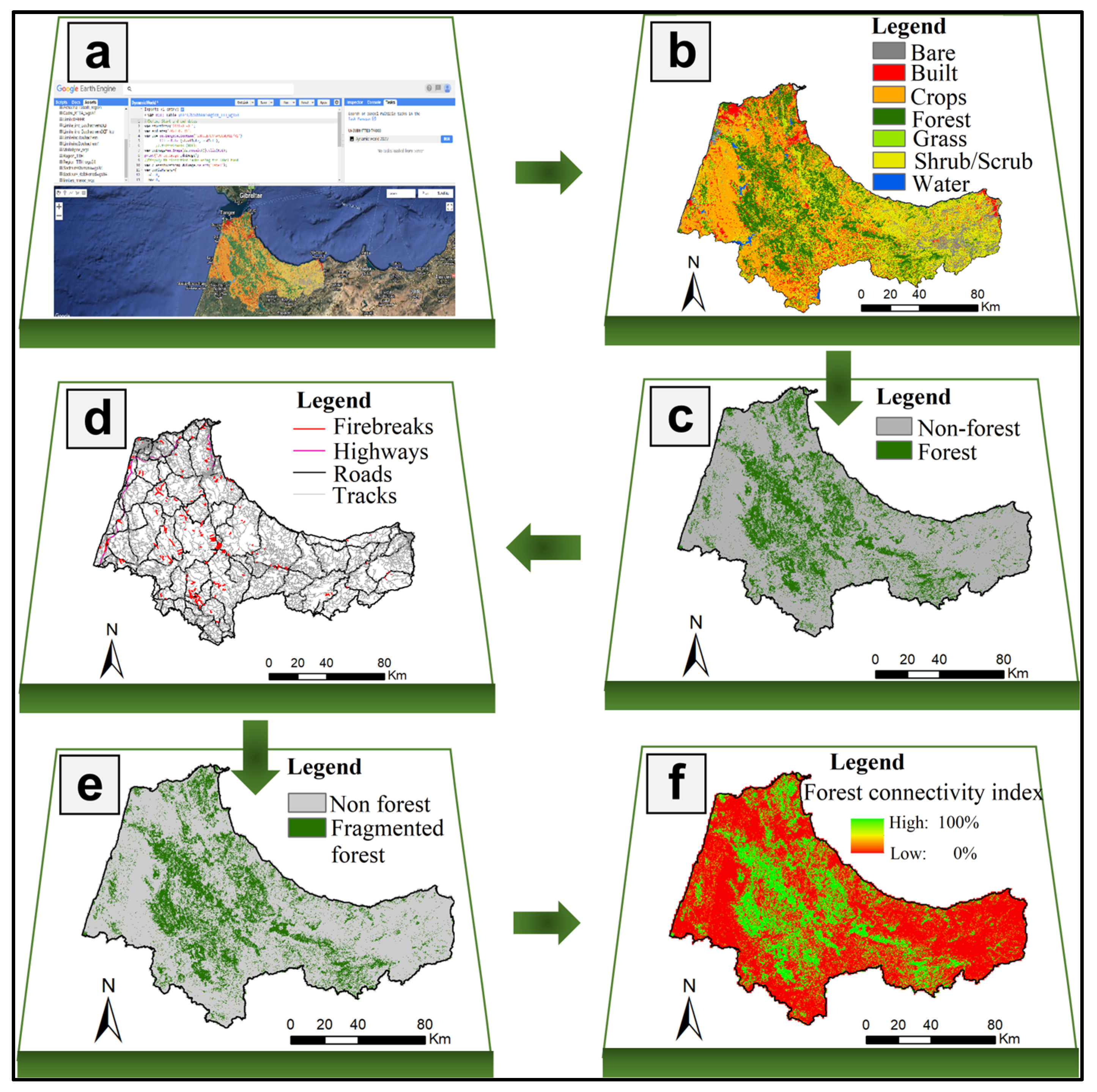
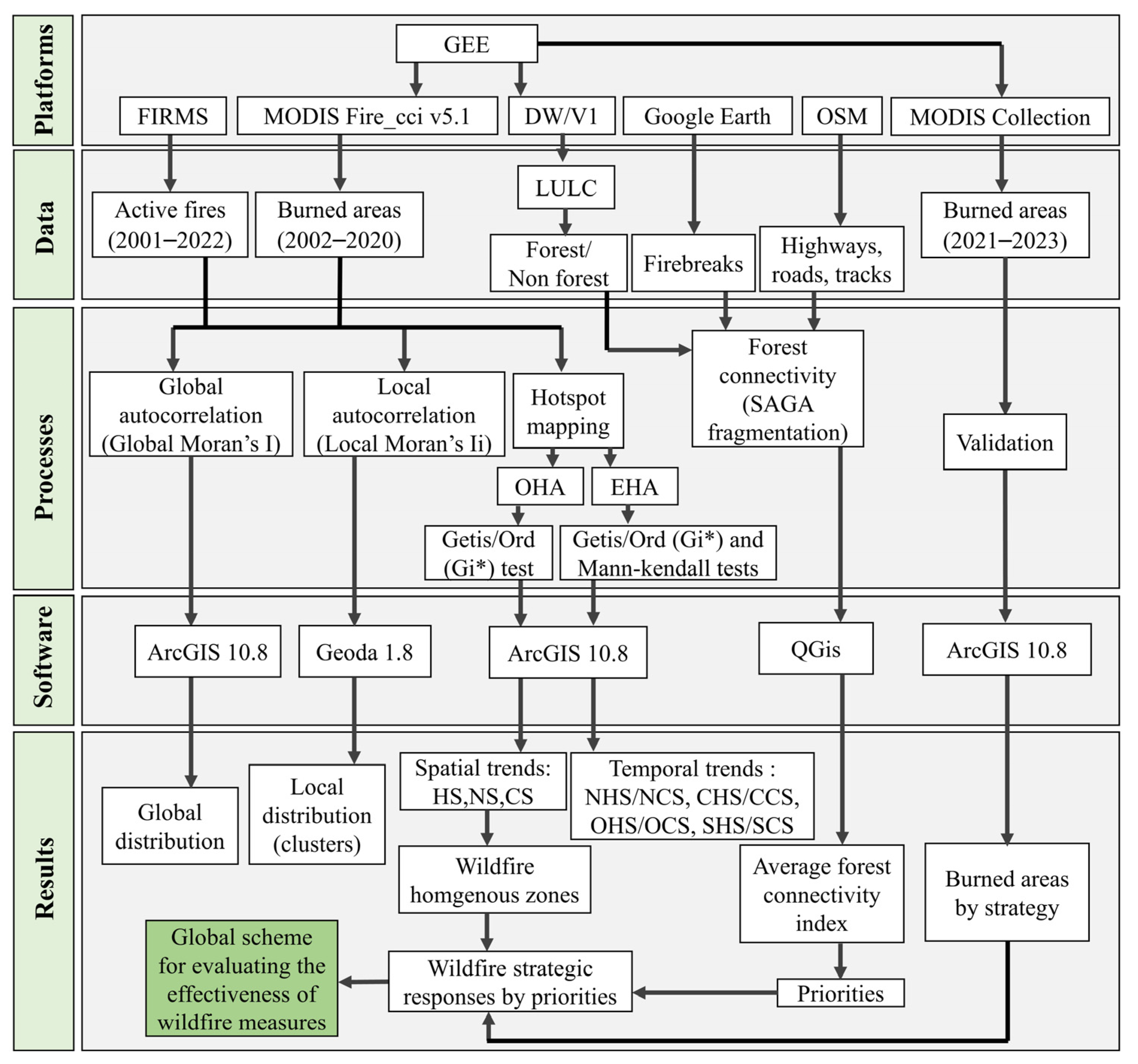
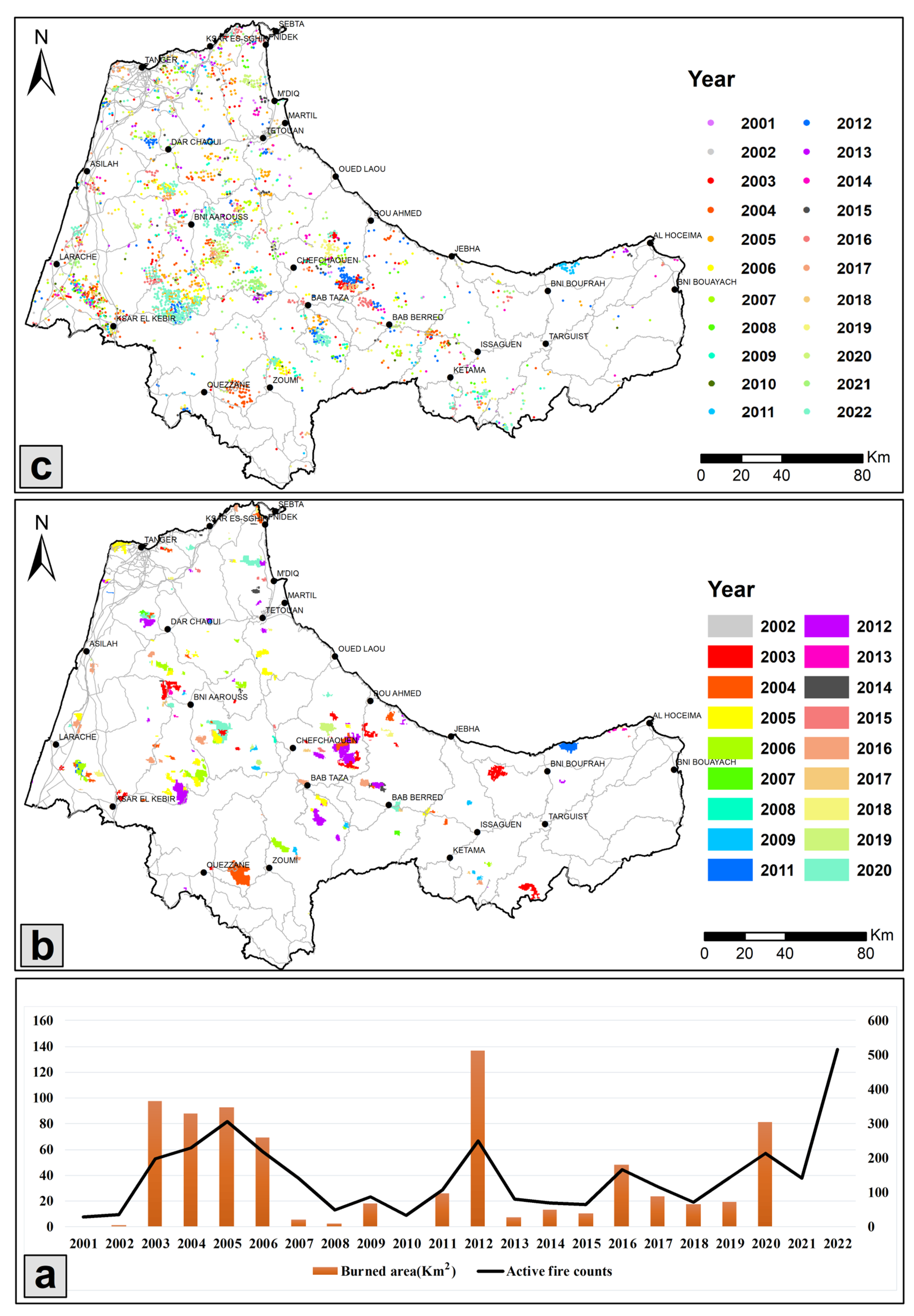
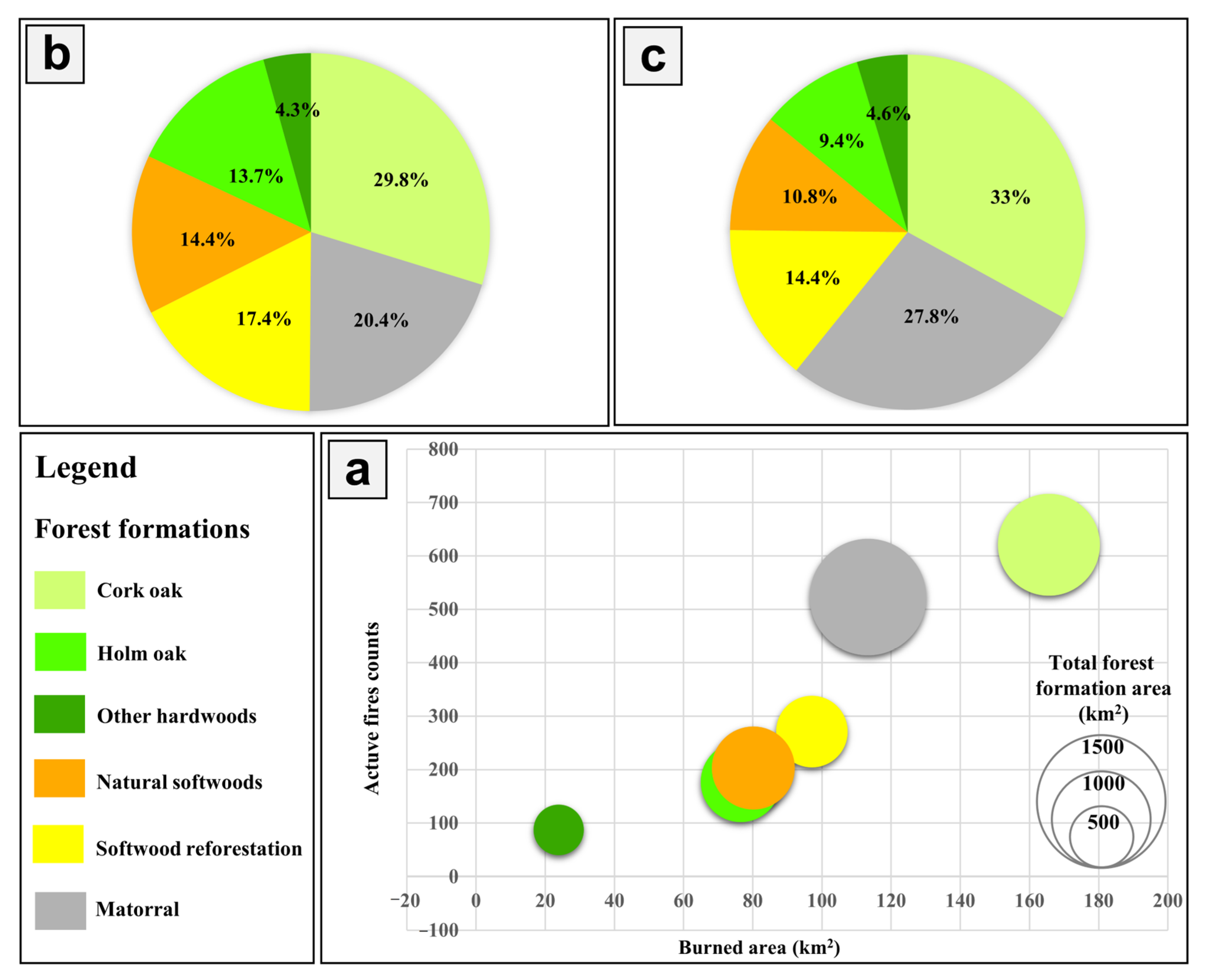
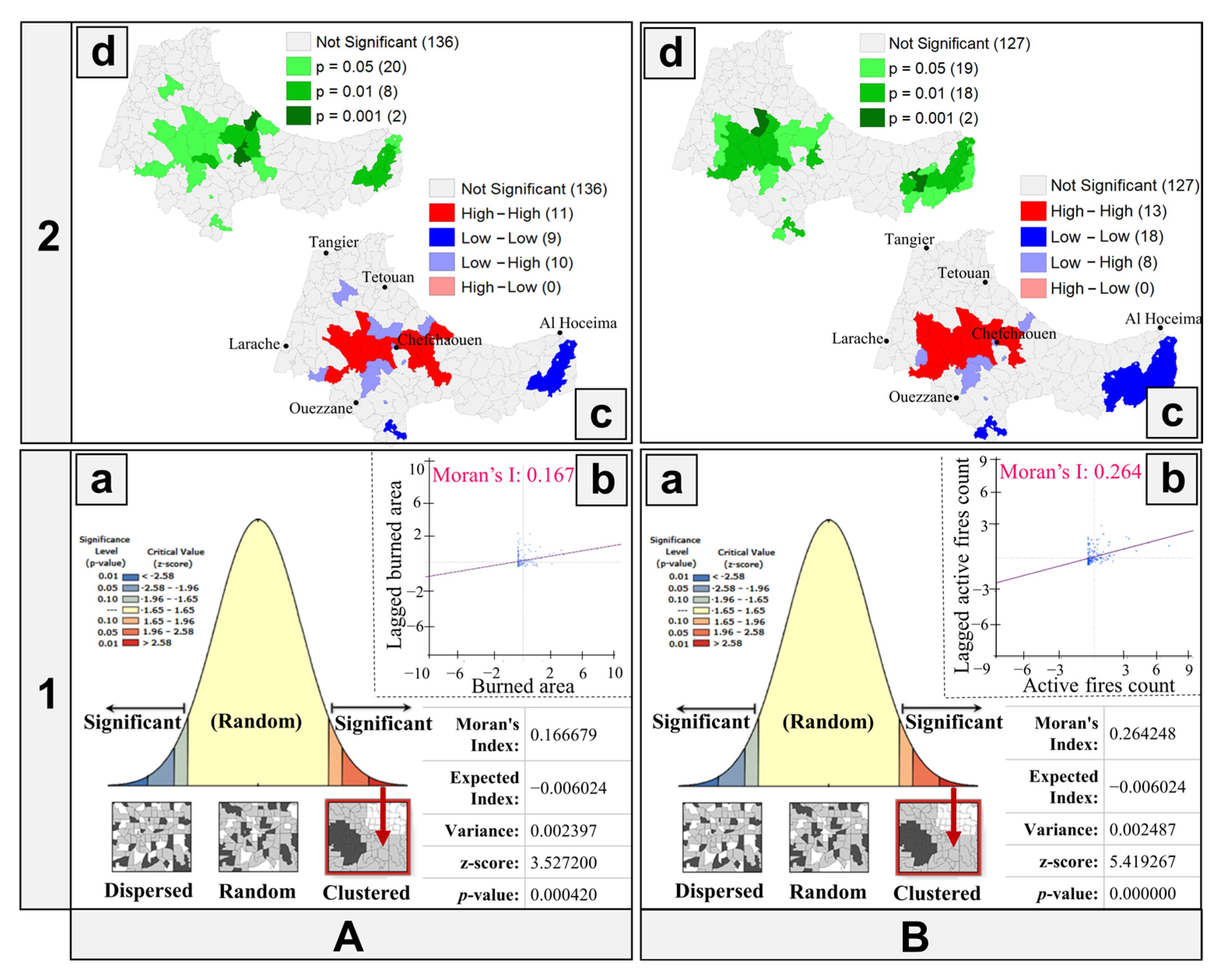
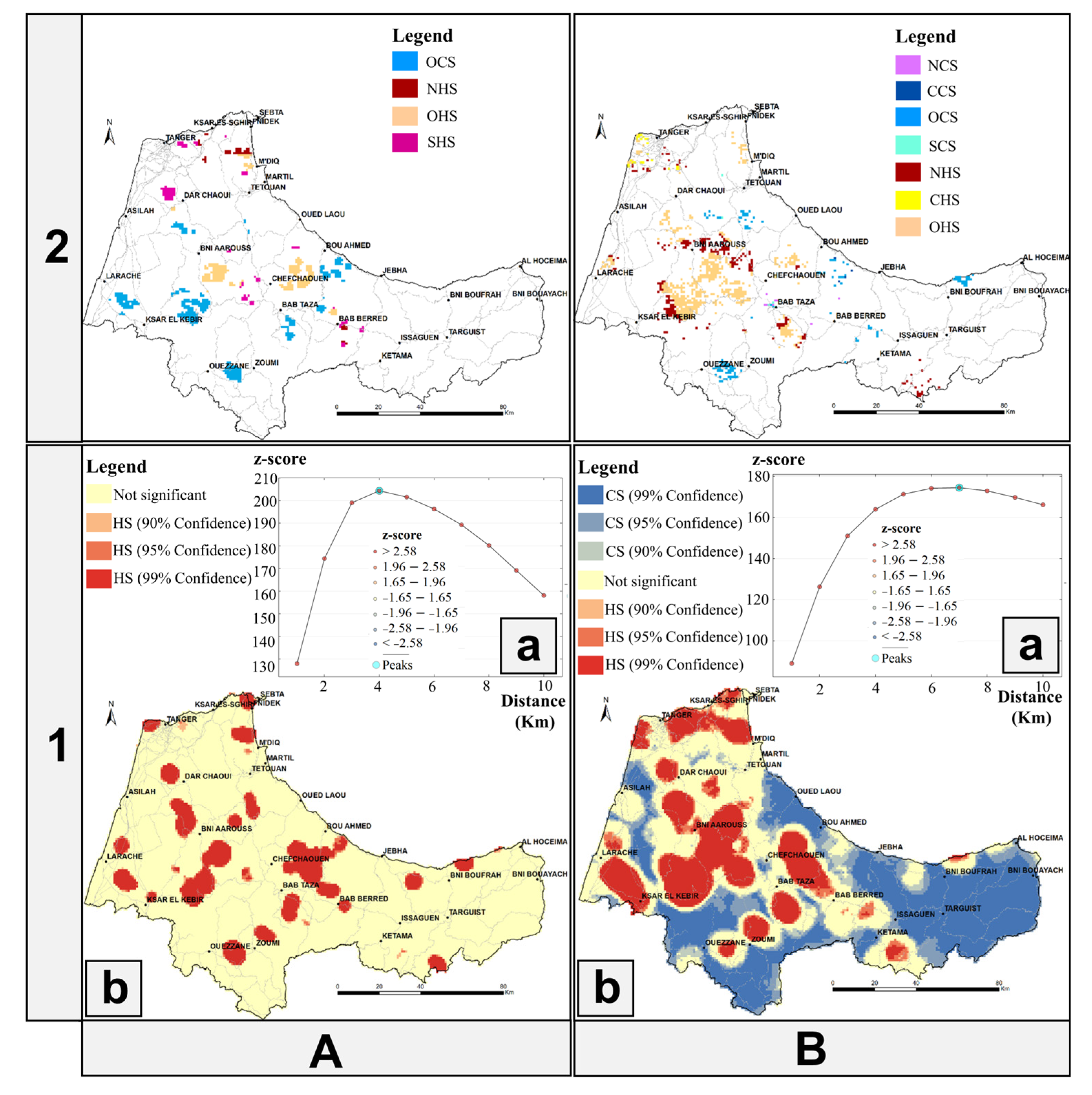
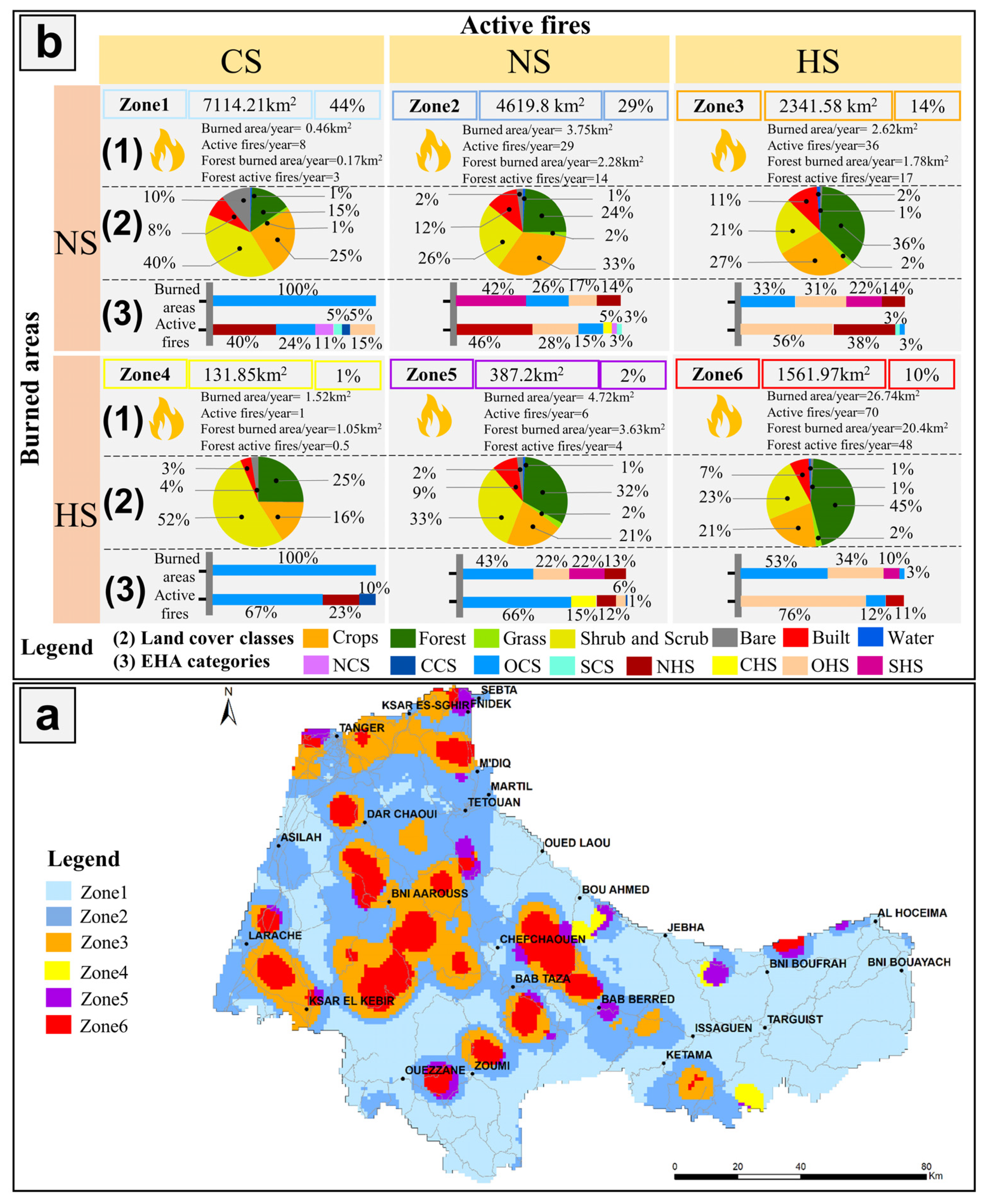
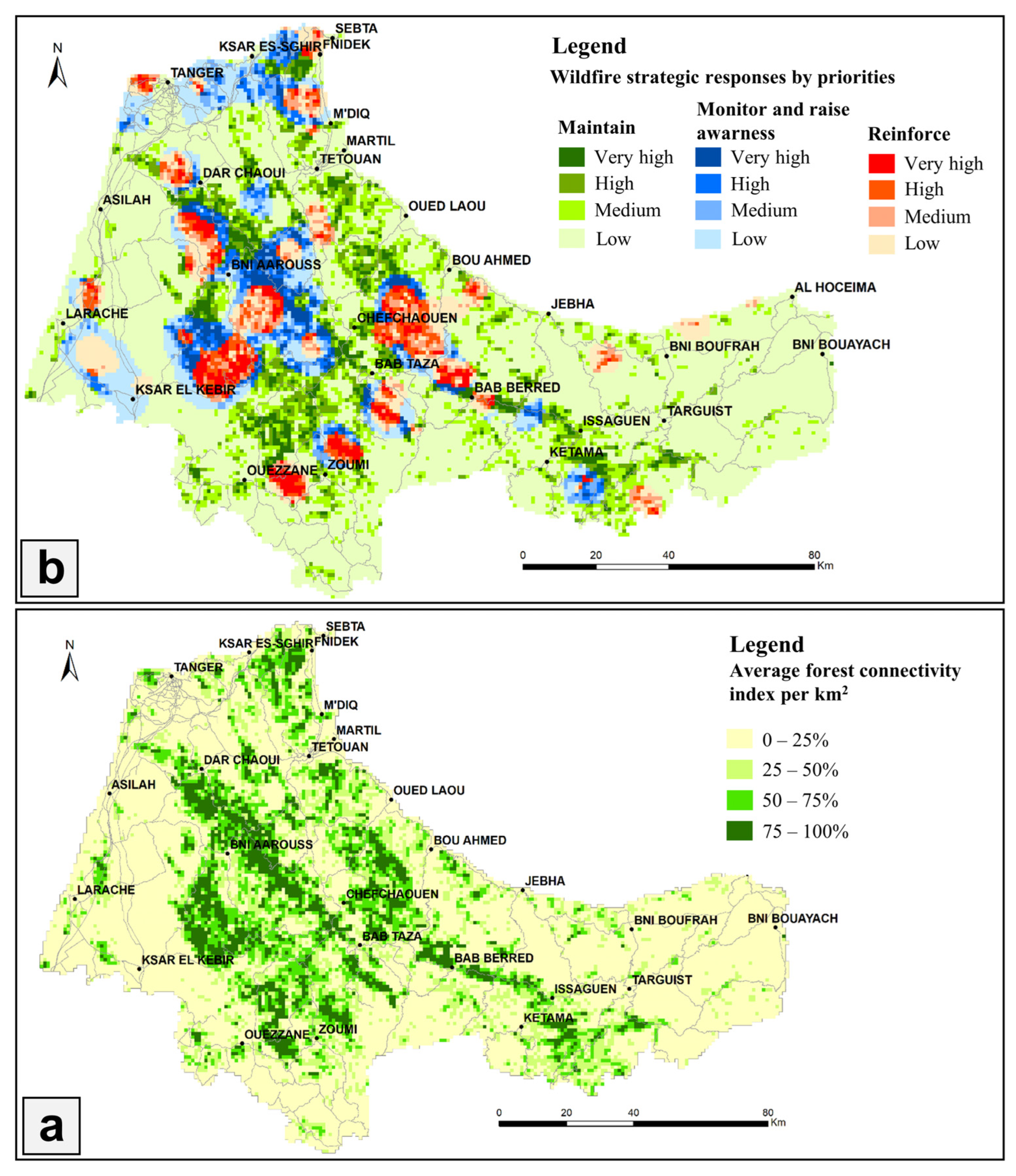
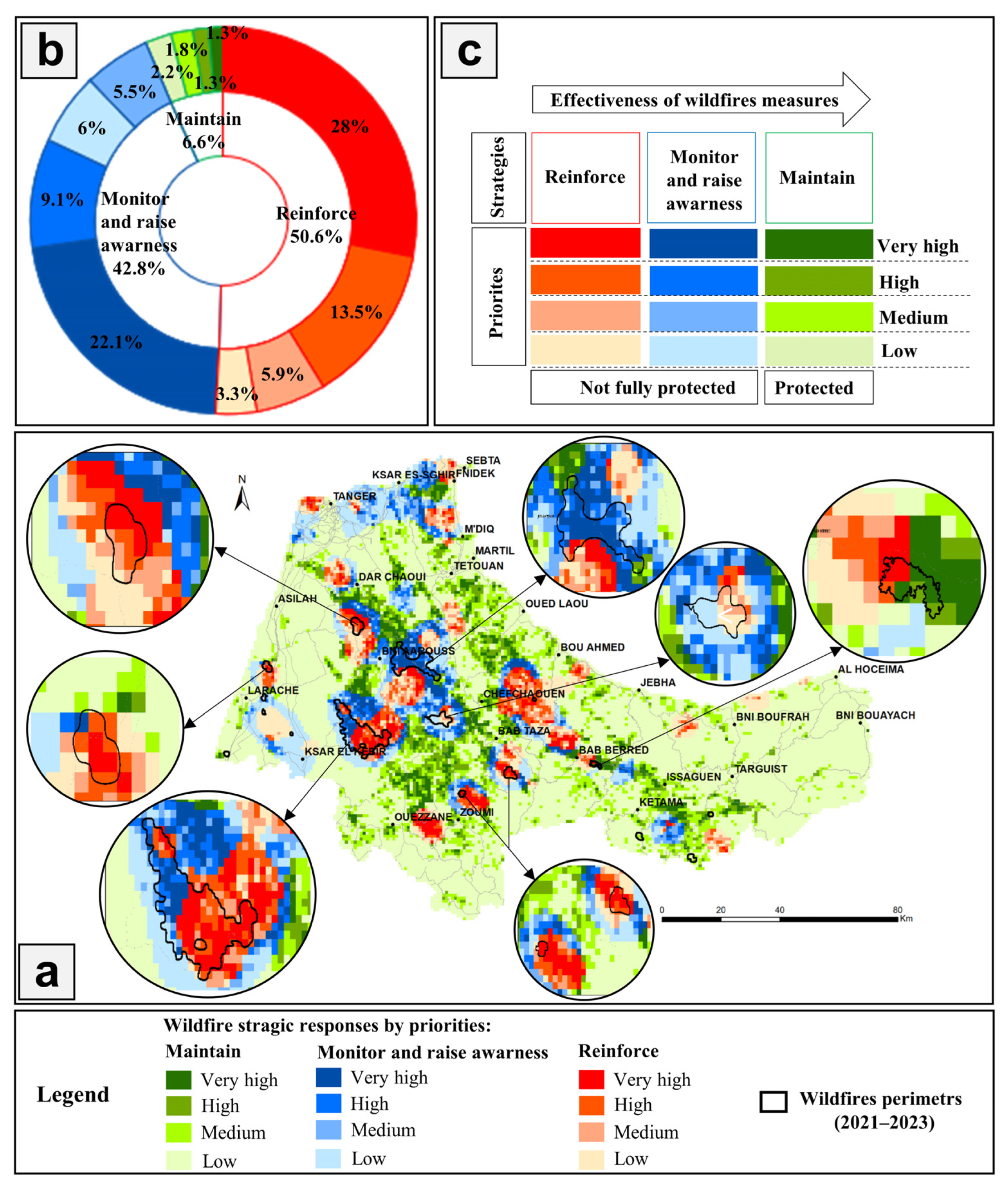
| Classe | Model Name | Definition |
|---|---|---|
| Hotspot (HS)/Coldspot (CS) | New hotspot (NHS)/ New coldspot (NCS) | Location representing a statistically significant HS/CS for the final time interval that has never been a statistically significant HS/CS before. |
| Consecutive hotspot (CHS)/ Consecutive coldspot (CCS) | Location representing a single uninterrupted series of at least two statistically significant HS/CS in the final time intervals. The location was never a statistically significant HS/CS prior to the final series of HS/CS, and less than 90% of all bins represent statistically significant HS/CS. | |
| Oscillating hotspot (OHS)/ Oscillating coldspot (OCS) | Statistically significant HS/CS for the final time interval that was also a statistically significant CS/HS during a previous time interval. Less than 90 percent of the time intervals were statistically significant HS/CS. | |
| Sporadic hotspot (SHS)/ Sporadic coldspot (SCS) | Statistically significant HS/CS for the final time interval with a reactivated, then deactivated HS/CS history. Less than 90% of the time intervals were statistically significant HS/CS, and none of the time intervals were statistically significant CS/HS. |
| Component | Actions |
|---|---|
| Prevention | Sensitization of the public to the dangers of fires and preventive measures: dissemination of awareness spots on television channels and announcements on the radio, popularization conferences at the level of douars, souks, etc. Prohibition of forestry activities that use fire in forests (in the summer season). Maintenance and clearing of the shoulders of roads, railways, and the rights of way of high voltage lines crossing the forests. Launch of silvicultural and plantation maintenance operations. Reinforcement of infrastructure and equipment in the forest environment, such as access roads, water points, forest tracks, and firebreak trenches. |
| Risk analysis | Development of prediction tools to assess the danger and anticipate the risks through static and dynamic maps of forest fires. Providing managers with a cartographic decision support tool to define priorities related to surveillance systems and firefighting infrastructure and equipment enhancements. |
| Preparation | Internally: Elaboration of programs, verification of equipment (rolling stock, small fighting equipment, clothing for firefighting personnel, means of communication and positioning, camping equipment, retardant products), and forest-defense-against-fires infrastructure. With partners: communication and awareness, clearing and cleaning (security strips of public and private infrastructure located near or in forests), coordination at the level of wilayas and provinces, finalization and implementation of the prevention and control system with partners. |
| Intervention | The intervention strategy is based on a graduated system with four levels of intervention: The first level is based on rapid management and support for the outbreak of fires by the services of the Water and Forests Department, thanks to first intervention vehicles and elements of Civil Protection with water tankers; The second level is reinforced, if necessary, by the use of bomber planes (Canadair) of the Royal Air Force and, at the ground level, by the Auxiliary Forces to protect populations, properties, and sensitive equipment; If the fire is not under control and continues to progress, the Royal Armed Forces, supported by the aircraft of the Royal Gendarmerie (Turbo Thrush) intervene at the third level. When the extent of the fire becomes difficult to control by national means, recourse to international assistance to reinforce the national fleet involved in the aerial fight against forest fires is requested. |
| Rehabilitation | Implementation of actions to protect the soil from erosion and the protection of the burned area. Reconstitution of the forest stand by natural or artificial regeneration actions. |
| Variables | Time Period | Statistical Parameters | Al Hoceima | Chefchaouen | Fahs-Anjra | Larache | Mdiq-Fnideq | Ouezzane | Tangier-Assilah | Tetouan | Total TTA Region |
|---|---|---|---|---|---|---|---|---|---|---|---|
| Burned areas (km2) | 2002–2020 | Number of observations | 19 | ||||||||
| Mean | 2.42 | 14.84 | 0.93 | 10.41 | 1.65 | 3.12 | 2.80 | 3.61 | 39.78 | ||
| Standard deviation | 4.72 | 21.72 | 1.20 | 12.20 | 3.53 | 9.06 | 4.52 | 6.59 | 41.24 | ||
| Minimum | 0.00 | 0.00 | 0.00 | 0.00 | 0.00 | 0.00 | 0.00 | 0.00 | 0.00 | ||
| Maximum | 15.42 | 84.72 | 3.69 | 33.82 | 14.51 | 38.42 | 14.30 | 23.91 | 136.82 | ||
| Sum | 45.92 | 281.88 | 17.74 | 197.87 | 31.33 | 59.19 | 53.22 | 68.59 | 755.74 | ||
| Active fires counts | 2001–2022 | Number of observations | 22 | ||||||||
| Mean | 9.14 | 38.82 | 9.55 | 48.50 | 3.86 | 8.82 | 9.86 | 20.68 | 149.23 | ||
| Standard deviation | 9.78 | 33.07 | 6.99 | 67.69 | 7.43 | 13.41 | 8.08 | 20.34 | 113.00 | ||
| Minimum | 0 | 3 | 1 | 5 | 0 | 0 | 1 | 3 | 30 | ||
| Maximum | 38 | 126 | 25 | 323 | 35 | 53 | 32 | 77 | 516 | ||
| Sum | 201 | 854 | 210 | 1067 | 85 | 194 | 217 | 455 | 3283 | ||
| OHA | EHA | ||||||||
|---|---|---|---|---|---|---|---|---|---|
| Province/Prefecture | NS | HS | Total | OCS | NHS | OHS | SHS | Total | |
| Al Hoceima | 3400.71 | 126.70 | 3527.41 | 0 | 0 | 0 | 0 | 0 | |
| Chefchaouen | 3166.71 | 733.28 | 3899.99 | 109 | 9 | 143 | 42 | 303 | |
| Fahs-Anjra | 639.84 | 22.96 | 662.80 | 0 | 17 | 0 | 12 | 29 | |
| Larache | 2145.19 | 587.97 | 2733.16 | 176 | 0 | 52 | 2 | 231 | |
| Mdiq-Fnideq | 137.79 | 106.11 | 243.90 | 0 | 16 | 19 | 0 | 35 | |
| Ouezzane | 1956.73 | 181.34 | 2138.06 | 57 | 0 | 0 | 0 | 57 | |
| Tangier-Assilah | 911.45 | 118.39 | 1029.83 | 0 | 0 | 0 | 39 | 39 | |
| Tetouan | 1717.18 | 204.30 | 1921.49 | 29 | 0 | 7 | 8 | 45 | |
| Total TTA region | Area (km2) | 14,075.59 | 2081.05 | 16,156.64 | 371 | 43 | 222 | 104 | 740 |
| % | 87.12 | 12.88 | 100 | 50.23 | 5.80 | 29.96 | 14.01 | 100 | |
| OHA | EHA | ||||||||||||
|---|---|---|---|---|---|---|---|---|---|---|---|---|---|
| Province/ Prefecture | CS | NS | HS | Total | NCS | CCS | OCS | SCS | NHS | CHS | OHS | Total | |
| Al Hoceima | 2891.14 | 509.97 | 126.30 | 3527.41 | 0 | 0 | 23 | 0 | 18 | 0 | 0 | 41 | |
| Chefchaouen | 1637.60 | 1264.63 | 997.76 | 3899.99 | 9 | 3 | 30 | 4 | 33 | 0 | 183 | 261 | |
| Fahs-Anjra | 30.88 | 258.15 | 373.77 | 662.80 | 0 | 0 | 0 | 0 | 6 | 3 | 5 | 14 | |
| Larache | 479.88 | 923.33 | 1329.96 | 2733.16 | 0 | 0 | 0 | 0 | 115 | 0 | 260 | 376 | |
| Mdiq-Fnideq | 0.00 | 103.74 | 140.16 | 243.90 | 0 | 0 | 0 | 0 | 0 | 0 | 18 | 18 | |
| Ouezzane | 1547.72 | 368.62 | 221.73 | 2138.06 | 0 | 0 | 48 | 0 | 6 | 0 | 3 | 57 | |
| Tangier-Assilah | 258.94 | 513.53 | 257.36 | 1029.83 | 0 | 0 | 0 | 0 | 14 | 20 | 14 | 48 | |
| Tetouan | 399.90 | 1065.07 | 456.52 | 1921.49 | 0 | 0 | 29 | 2 | 39 | 0 | 45 | 115 | |
| Total TTA region | Area (km2) | 7246.06 | 5007.03 | 3903.55 | 16,156.64 | 9 | 3 | 130 | 6 | 232 | 22 | 529 | 931 |
| % | 44.85 | 30.99 | 24.16 | 100 | 0.92 | 0.31 | 13.93 | 0.65 | 24.92 | 2.40 | 56.87 | 100 | |
| Strategy | Maintain | Monitor and Raise Awareness | Reinforce | |||||||||||||
|---|---|---|---|---|---|---|---|---|---|---|---|---|---|---|---|---|
| Priority | Very High | High | Medium | Low | Total | Very High | High | Medium | Low | Total | Very High | High | Medium | Low | Total | |
| Province/ Prefecture | Tetouan | 137.0 | 227.3 | 298.5 | 741.6 | 1404.4 | 68.1 | 63.4 | 74 | 107.3 | 312.8 | 35.6 | 35.2 | 52.7 | 80.8 | 204.3 |
| Al Hoceima | 67.7 | 132.2 | 412.2 | 2695.1 | 3307.3 | 11.9 | 22.6 | 34.1 | 24.9 | 93.4 | 5.1 | 13.5 | 33.3 | 74.8 | 126.7 | |
| Ouezzane | 112.1 | 194.4 | 343.3 | 1218.7 | 1868.4 | 7.5 | 15.4 | 40 | 25.3 | 88.3 | 80.8 | 39.2 | 26.5 | 34.8 | 181.3 | |
| Chefchaouen | 161.9 | 255.4 | 489.8 | 1758 | 2665.1 | 114.8 | 101.4 | 111.3 | 174.2 | 501.7 | 127.5 | 171.8 | 172.2 | 261.7 | 733.3 | |
| Larache | 78 | 75.6 | 92.6 | 1123.7 | 1369.9 | 145.7 | 132.2 | 109.7 | 387.6 | 775.2 | 140.2 | 137.8 | 90.3 | 219.7 | 588 | |
| Tanger–Assilah | 5.9 | 23.8 | 49.1 | 671.9 | 750.7 | 4.8 | 13.5 | 22.2 | 120.4 | 160.8 | 15.4 | 35.6 | 22.2 | 45.1 | 118.4 | |
| Fahs-Anjra | 23.8 | 28.5 | 46.7 | 189.7 | 288.6 | 29.3 | 65.3 | 103.7 | 152.8 | 351.2 | 1.2 | 3.6 | 5.5 | 12.7 | 23 | |
| Mdiq–Fnideq | 9.1 | 9.5 | 8.7 | 52.3 | 79.6 | 4.4 | 17.8 | 11.5 | 24.5 | 58.2 | 10.3 | 19 | 33.3 | 43.6 | 106.1 | |
| Total region | Area (km2) | 595.5 | 946.7 | 1740.9 | 8450.9 | 11,734 | 386.4 | 431.6 | 506.4 | 1017.2 | 2341.6 | 416.1 | 455.7 | 435.9 | 773.3 | 2081 |
| Priority % | 5.1 | 8.1 | 14.8 | 72 | 100 | 16.5 | 18.4 | 21.6 | 43.5 | 100 | 20 | 21.9 | 20.9 | 37.2 | 100 | |
| Strategy % | 72.6 | 14.5 | 12.9 | |||||||||||||
Disclaimer/Publisher’s Note: The statements, opinions and data contained in all publications are solely those of the individual author(s) and contributor(s) and not of MDPI and/or the editor(s). MDPI and/or the editor(s) disclaim responsibility for any injury to people or property resulting from any ideas, methods, instructions or products referred to in the content. |
© 2023 by the authors. Licensee MDPI, Basel, Switzerland. This article is an open access article distributed under the terms and conditions of the Creative Commons Attribution (CC BY) license (https://creativecommons.org/licenses/by/4.0/).
Share and Cite
Boubekraoui, H.; Maouni, Y.; Ghallab, A.; Draoui, M.; Maouni, A. Wildfires Risk Assessment Using Hotspot Analysis and Results Application to Wildfires Strategic Response in the Region of Tangier-Tetouan-Al Hoceima, Morocco. Fire 2023, 6, 314. https://doi.org/10.3390/fire6080314
Boubekraoui H, Maouni Y, Ghallab A, Draoui M, Maouni A. Wildfires Risk Assessment Using Hotspot Analysis and Results Application to Wildfires Strategic Response in the Region of Tangier-Tetouan-Al Hoceima, Morocco. Fire. 2023; 6(8):314. https://doi.org/10.3390/fire6080314
Chicago/Turabian StyleBoubekraoui, Hamid, Yazid Maouni, Abdelilah Ghallab, Mohamed Draoui, and Abdelfettah Maouni. 2023. "Wildfires Risk Assessment Using Hotspot Analysis and Results Application to Wildfires Strategic Response in the Region of Tangier-Tetouan-Al Hoceima, Morocco" Fire 6, no. 8: 314. https://doi.org/10.3390/fire6080314
APA StyleBoubekraoui, H., Maouni, Y., Ghallab, A., Draoui, M., & Maouni, A. (2023). Wildfires Risk Assessment Using Hotspot Analysis and Results Application to Wildfires Strategic Response in the Region of Tangier-Tetouan-Al Hoceima, Morocco. Fire, 6(8), 314. https://doi.org/10.3390/fire6080314








